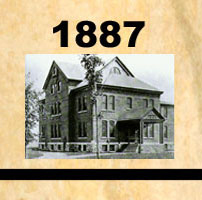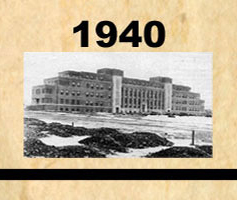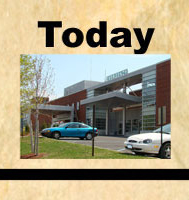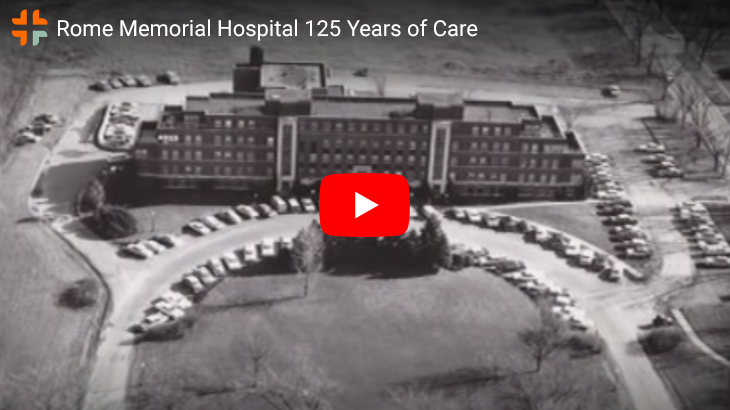Serving the Community for Over a Century
For more than a century, Rome's hospital has served the historic Central New York community at the foothills of the Adirondacks. What began as a small "cottage" hospital - serving 19 patients in 1884, its first year of operation - has evolved into the busy Rome Memorial Hospital it is today. We care for about 6,000 patients a year in our 129 acute care beds and are home to 80 residents in our skilled nursing facility. In a year's time, the community's residents make more than 100,000 visits to our outpatient facilities for diagnostic testing and treatment.
Dr. Thomas M. Flandrau and his wife, Clarissa Foote Flandrau, are credited as being the co-founders because of their efforts to arouse public sentiment following a railroad accident. The victims were cared for at the Flandraus´ private residence because there was no other place. Their efforts were a success and on April 3, 1884, the Cottage Hospital on Ridge Street admitted its first patient.
Bigger Hospital for More People
 As Rome's population grew, it wasn't long before it became apparent that the city needed more than the Cottage Hospital. The move was also spurred by problems posed by the railroad tracks that ran in front of the Cottage Hospital. The ladies involved in the hospital's operation voiced objections to having to cross the tracks to reach the facility and the cottage hospital vibrated from the noise of passing trains. Dr. Flandrau laid the cornerstone for the new Rome Hospital on September 27, 1887.
As Rome's population grew, it wasn't long before it became apparent that the city needed more than the Cottage Hospital. The move was also spurred by problems posed by the railroad tracks that ran in front of the Cottage Hospital. The ladies involved in the hospital's operation voiced objections to having to cross the tracks to reach the facility and the cottage hospital vibrated from the noise of passing trains. Dr. Flandrau laid the cornerstone for the new Rome Hospital on September 27, 1887.
With further growth of the community, it was necessary for the hospital to expand a number of times. In 1905, an annex was added to the Garden Street facility to provide space for a nursing school and living quarters for the nurses. Just 13 years later when the hospital needed the annex space for the care of patients, a new nurses’ home was constructed adjacent to the existing facility.
Bequest Gives City a Second Hospital
In 1920, James A. Murphy´s $50,000 bequest at the time of his death provided for an additional hospital in the city of Rome. Murphy Memorial Hospital was located on West Embargo Street - now the site of John F. Kennedy Ice-skating Arena and the Municipal Swimming Pool. The facility served patients with contagious diseases as well as provided surgical services.
In 1929, the city took over operation of both facilities and Murphy Memorial became a maternity hospital. By 1935, however, overcrowding and the state of disrepair of both buildings resulted in the planning for one consolidated hospital building. Newspaper reports told of laundry baskets pressed into service as makeshift bassinets for sleeping babies and patient beds located in corridors with only screens for privacy.
City’s Hospitals Merge and Relocate
 After much wrangling over site selection, the city built a combined Rome Hospital and Murphy Memorial Hospital on the current North James Street site. The new hospital opened for public inspection April 10, 1940, with 119 adult beds and 2 for children, which was more than double the beds of the old facilities.
After much wrangling over site selection, the city built a combined Rome Hospital and Murphy Memorial Hospital on the current North James Street site. The new hospital opened for public inspection April 10, 1940, with 119 adult beds and 2 for children, which was more than double the beds of the old facilities.
More Growth and Expansion
Before long, additional wings were added to the front of the facility in 1967 to allow larger numbers of patients to be served. In 1976, the addition of the Bartlett Wing allowed for 88 more patients beds, almost half of which were designated for skilled nursing patients. The wing was named in honor of Dr. Robert L. Bartlett, past superintendent of the former Oneida County Hospital. Bartlett's family donated $350,000 in his memory to Oneida County for the wing.
Financial Challenges Pave
Road to Privatization
The 1980s and early 1990s proved to be very financially challenging for the municipally-owned hospital. With 12 years of operating losses totaling over $12 million, the hospital was close to bankrupting the City. To ensure that Rome continued to have a hospital without burdening the taxpayers, the city transferred ownership of the hospital to a private, not-for-profit corporation. Rome Memorial Hospital came into existence Dec. 31, 1994.
 Free from the additional layer of management, the hospital has since been successful in launching several new services and expanding services to a number of off-site locations. From our humble beginnings, we have evolved into a valuable community asset by providing a full range of primary and secondary healthcare services and more than 1,000 jobs. After more than a century of service, our commitment continues . . .
Free from the additional layer of management, the hospital has since been successful in launching several new services and expanding services to a number of off-site locations. From our humble beginnings, we have evolved into a valuable community asset by providing a full range of primary and secondary healthcare services and more than 1,000 jobs. After more than a century of service, our commitment continues . . .


